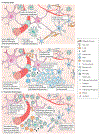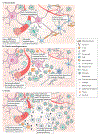Drug delivery to the central nervous system
- PMID: 38464996
- PMCID: PMC10923597
- DOI: 10.1038/s41578-021-00394-w
Drug delivery to the central nervous system
Abstract
Despite the rising global incidence of central nervous system (CNS) disorders, CNS drug development remains challenging, with high costs, long pathways to clinical use and high failure rates. The CNS is highly protected by physiological barriers, in particular, the blood-brain barrier and the blood-cerebrospinal fluid barrier, which limit access of most drugs. Biomaterials can be designed to bypass or traverse these barriers, enabling the controlled delivery of drugs into the CNS. In this Review, we first examine the effects of normal and diseased CNS physiology on drug delivery to the brain and spinal cord. We then discuss CNS drug delivery designs and materials that are administered systemically, directly to the CNS, intranasally or peripherally through intramuscular injections. Finally, we highlight important challenges and opportunities for materials design for drug delivery to the CNS and the anticipated clinical impact of CNS drug delivery.
Conflict of interest statement
Competing interests The authors declare no competing interests.
Figures







